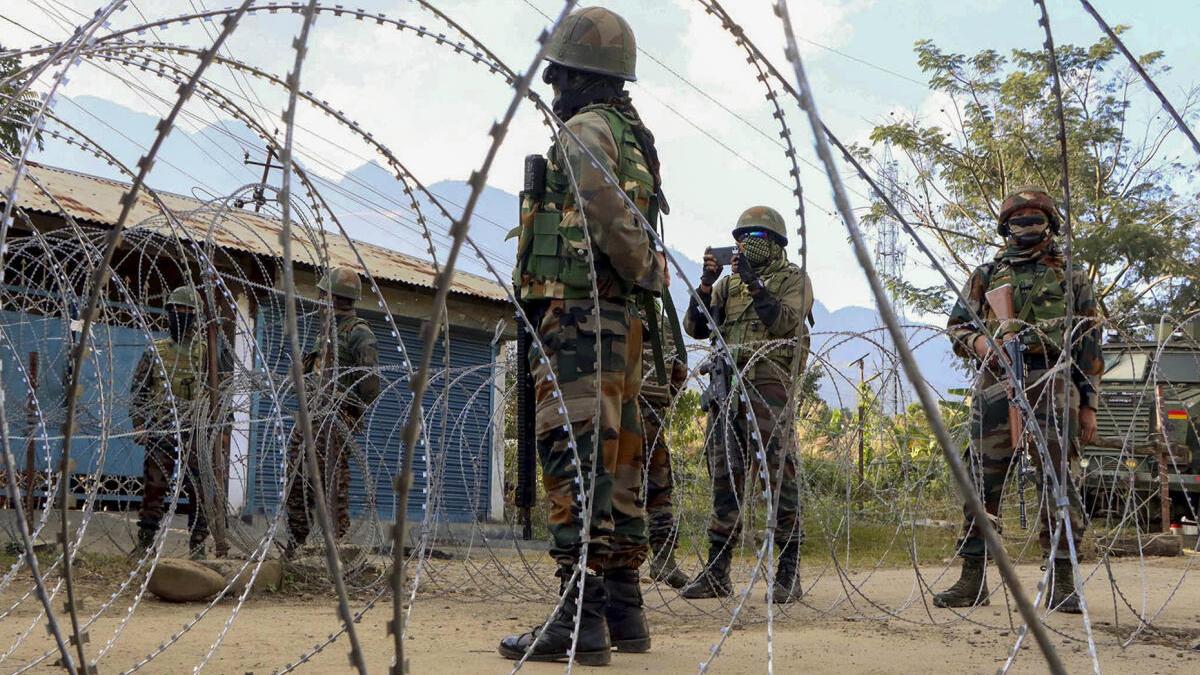Security personnel stand guard during a protest at in the Kangpokpi district of Manipur in November last year.
| Photo Credit: PTI
The ongoing conflict in Manipur has had a significant impact on the State’s economy. The revenue flow from GST has slowed down drastically, while retail inflation levels have skyrocketed. The double whammy came amid over 1,000 hours of Internet shutdowns last year preceded by more than 4,300 hours in 2023. While ethnic violence continues to lead to numerous deaths, the theatre of conflict has now shifted to the peripheral districts of Jiribam and Kamjong.
While the growth rate of GST revenues from Manipur was among the highest across all States between FY18 and FY19 and between FY19 and FY20, it was among the lowest between FY23 and FY24. Manipur collected ₹670 crore in GST revenues in FY24, an 8.9% increase from FY23 — the fifth lowest growth rate among 31 States and Union Territories. In contrast, it had ranked second and third in India in terms of GST growth rate in FY18-FY19 and FY19-FY20.

Chart 1 compares the GST growth rates for India and Manipur. Manipur’s GST growth rate was 2.5 times higher than India’s between FY18 and FY19, and five times higher than India’s between FY19 and FY20. However, in FY23-FY24, Manipur’s GST growth rate was three-fifths of India’s.
Chart appears incomplete? Click to remove AMP mode
While the rise in cost of living, driven in part by an increase in food prices, is a pan-India concern, the rise in retail inflation is pinching the wallets of Manipuri consumers more than anywhere else in the country. Before the start of hostilities in May 2023, Manipur had the lowest retail inflation among all the States. In January 2023, while the average Indian retail inflation was exceeding 6%, it was just 1.7% in Manipur. In May 2023, while the average inflation in India was 4.3%, inflation climbed to 9.5% in Manipur, the highest among all the States.
Since then, inflation in Manipur has remained higher than the all-India average across most months. The inflation rates in May, June, and July 2024 were the only exceptions to the trend and this was mainly due to the base effect. In January 2025, while Indian retail inflation eased to a five-month low of 4.3%, the corresponding number was 7.4% for Manipur (Chart 2).
Apart from price rise, Internet shutdowns have disrupted life and work in Manipur in the last two years. An Internet shutdown was first imposed in the districts of Churachandpur and Pherzawl on April 28, 2023. It was extended to the whole State on May 3, 2023, following communal clashes. The Internet shutdown in Manipur lasted 200 days in 2023, which is the longest in the north-east and the second longest in the country after Jammu and Kashmir. Shutdowns continued in 2024, with the latest recorded last December.

A district-wise breakdown of Internet shutdowns since 2023 shows that Churachandpur is the worst affected (about 30 shutdowns) followed by Imphal East, Imphal West, Bishnupur, and Thoubal (more than 25 shutdowns each). Kakching and Kangpokpi have experienced 23 and 21 shutdowns, respectively.
As noted before, the theatre of conflict has shifted. In the first year of the conflict (May 2023 to June 2024), the majority of conflict-related fatalities were concentrated in the districts of Imphal east, Imphal west, Bishnupur, Kangpokpi, Kakching, Thoubal and Tengnoupal (Map 3A).
However, communal tensions began to rise in the peripheral district of Jiribam after the murder of a Meitei farmer in June 2024. From the second half of 2024 (Map 3B), while fatalities occurred everywhere, many were reported from the Jiribam and Kamjong districts.
Source: MOSPI, GST portal and ACLED (Armed Conflict Location and Event Data)
Published – February 25, 2025 08:00 am IST
